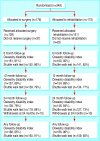Randomised controlled trial to compare surgical stabilisation of the lumbar spine with an intensive rehabilitation programme for patients with chronic low back pain: the MRC spine stabilisation trial
- PMID: 15911537
- PMCID: PMC558090
- DOI: 10.1136/bmj.38441.620417.8F
Randomised controlled trial to compare surgical stabilisation of the lumbar spine with an intensive rehabilitation programme for patients with chronic low back pain: the MRC spine stabilisation trial
Erratum in
- BMJ. 2005 Jun 25;330(7506):1485
Abstract
Objectives: To assess the clinical effectiveness of surgical stabilisation (spinal fusion) compared with intensive rehabilitation for patients with chronic low back pain.
Design: Multicentre randomised controlled trial.
Setting: 15 secondary care orthopaedic and rehabilitation centres across the United Kingdom.
Participants: 349 participants aged 18-55 with chronic low back pain of at least one year's duration who were considered candidates for spinal fusion.
Intervention: Lumbar spine fusion or an intensive rehabilitation programme based on principles of cognitive behaviour therapy.
Main outcome measure: The primary outcomes were the Oswestry disability index and the shuttle walking test measured at baseline and two years after randomisation. The SF-36 instrument was used as a secondary outcome measure.
Results: 176 participants were assigned to surgery and 173 to rehabilitation. 284 (81%) provided follow-up data at 24 months. The mean Oswestry disability index changed favourably from 46.5 (SD 14.6) to 34.0 (SD 21.1) in the surgery group and from 44.8 (SD14.8) to 36.1 (SD 20.6) in the rehabilitation group. The estimated mean difference between the groups was -4.1 (95% confidence interval -8.1 to -0.1, P = 0.045) in favour of surgery. No significant differences between the treatment groups were observed in the shuttle walking test or any of the other outcome measures.
Conclusions: Both groups reported reductions in disability during two years of follow-up, possibly unrelated to the interventions. The statistical difference between treatment groups in one of the two primary outcome measures was marginal and only just reached the predefined minimal clinical difference, and the potential risk and additional cost of surgery also need to be considered. No clear evidence emerged that primary spinal fusion surgery was any more beneficial than intensive rehabilitation.
Figures
Comment in
-
Surgery versus intensive rehabilitation programmes for chronic low back pain.BMJ. 2005 May 28;330(7502):1220-1. doi: 10.1136/bmj.330.7502.1220. BMJ. 2005. PMID: 15920106 Free PMC article. No abstract available.
-
Rehab as good as spinal fusion for chronic back pain.J Fam Pract. 2005 Sep;54(9):752. J Fam Pract. 2005. PMID: 16189890 No abstract available.
-
[Operations].Orthopade. 2012 Dec;41(12):991. doi: 10.1007/s00132-012-1976-x. Orthopade. 2012. PMID: 23192730 German. No abstract available.
References
-
- Katz J. Lumbar spinal fusion: surgical rates, costs, and complications. Spine 1995;20: 78S-83S. - PubMed
-
- Department of Health (England). Hospital episode statistics, 1998-2003. London: DoH, 2003 1998.
-
- Cherkin D, Deyo R, Loeser J, Bush T, Waddell G. An international comparison of back surgery rates. Spine 1994;19: 1201-6. - PubMed
-
- Deyo RA, Gray DT, Kreuter W, Mirza S, Martin, BI. United States trends in lumbar fusion surgery for degenerative conditions. Spine 2005. (in press). - PubMed
-
- Gibson J, Grant I, Waddell G. The Cochrane review of surgery for lumbar disc prolapse and degenerative lumbar spondylosis. Spine 1999;24: 1820-32. - PubMed
Publication types
MeSH terms
LinkOut - more resources
Full Text Sources
Medical
Molecular Biology Databases

